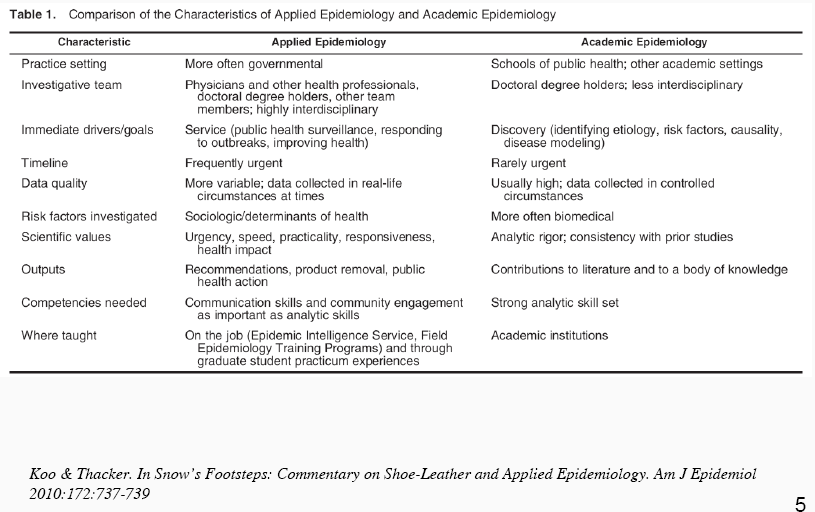Unlike many scientific disciplines, undergraduate training in epidemiology is fairly rare. I've met a lot of public health students over the past few months, but only a few majored as an undergrad in public health or something similar, and I haven't met anyone whose degree was in epidemiology. For the most part, people come to epidemiology from other fields: there are many physicians, and lots of pre-med student who decided they didn't want to be doctors (like me) or still want to be. This has many implications for the field, including a bias towards looking at problems primarily through a biomedical lens, rather than through sociological, political, economic, or anthropological ones.
Another interesting consequence of this lack of (or only cursory) study of epidemiology before graduate school is that the introductory courses in epidemiology at most schools of public health are truly introductory. If you're a graduate student in biochemistry and molecular biology (my undergraduate field), my guess is that it's assumed you know something about the structure of nucleic acids, have drawn the Krebs cycle at some point, and may even have heard the PCR song.
In epidemiology we're essentially starting from scratch, so there's a need to move rapidly from having no common, shared knowledge, through learning basic vocabulary (odds ratios, relative risk differences, etc.), all the way to analyzing extremely complex research. This presents pedagogical difficulties, of course, and it also makes it easier to miss out on the "big picture" of the field of epidemiology.
For one of our earliest discussion labs in my epidemiologic methods course, we discussed a couple papers on smoking and lung cancer. While "everyone knows" today that smoking causes lung cancer, it's a useful exercise to go back and look at the papers that actually established that as a scientific fact. In terms of teaching, it's a great case-study for thinking about causality like an epidemiologist. After all, most people who smoke never get lung cancer, and some people get lung cancer without ever smoking, so establishing causality requires a bit more thought. Two of the papers we read are great for illustrating some changes that have occurred as epidemiology has changed and matured over the last 50 years.
The first paper we looked at is "The Mortality of Doctors in Relation to Their Smoking Habits: A Preliminary Report," written by Richard Doll and Bradford Hill in the British Medical Journal in 1954. (Free PDF here) Doll and Hill followed up their groundbreaking study with "Mortality in relation to smoking: 50 years' observations on male British doctors" in 2004 (available here).
A few observations: First, the 1954 paper is much shorter: around 4 1/2 pages of text compared to 8 1/2 in the 2004 article. The 1954 paper is much more readable as well: it's conversational and uses much less specialized vocabulary (possibly because some of that vocabulary simply didn't exist in 1954). The graphs are also crude and ugly compared to the computer-generated ones in 2004.
The 2004 paper also ends with this note: "Ethical approval: No relevant ethics committees existed in 1951, when the study began."
Beyond the differences in style, length, and external approval by an ethics committee, the changes in authorship are notable. The original paper was authored by merely two people: a physician and a statistician. The 2004 paper adds two additional authors for a total of 4 (still small compared to many papers) -- and notably, the two new authors are both female. During those 50 years there was of course great progress in terms of women's representation in scientific research. While that record is still spotty in some areas, schools of public health today are producing many more female scholars than males -- for example, current public health students at Hopkins are 71% female.
There has been a definite shift from the small-scale collaboration resulting in a paper with an individual, conversational style to the large-scale collaboration resulting in an extremely institutional output. One excellent example of this is a paper I read for an assignment today: "Serum B Vitamin Levels and Risk of Lung Cancer" by Johansson et al. in JAMA, 2010 (available here).
The Johansson et al. paper has ~8 pages of text, 47 references, 2 tables and 2 figures (all of which are quite complicated) and a number of online supplements. Its 46 authors have between them (by my count) 33 PhDs, 27 MDs, 3 MPHs, and 6 other graduate degrees! It's hard to tell gender just by name, but by my count at least half of the authors are likely female.
Clearly, epidemiology has changed a lot in the last 50 years. Gone are the days of (at least explicit) male domination. Many of the problems with the field today are related to information management and large-scale collaborations. Gone are the days of one or two researchers publishing ground-breaking studies on their own -- many of the "easy" discoveries have been made. Yet many of the examples we learn from -- and role models young public health researchers may want to emulate -- are from an earlier era.
